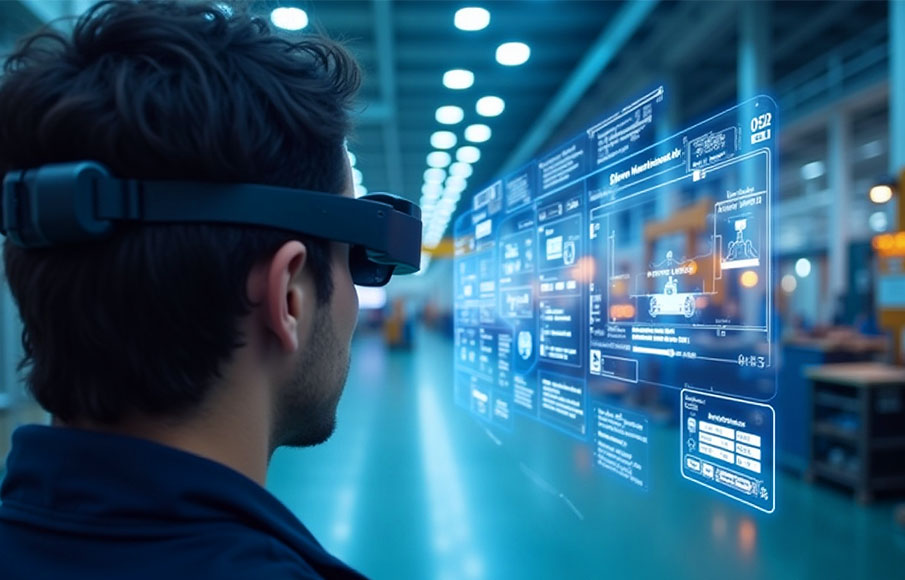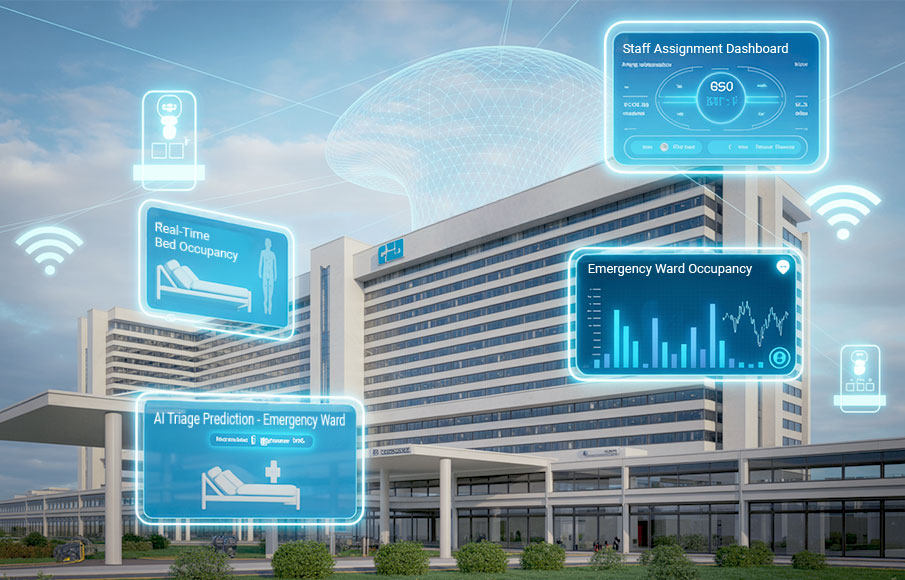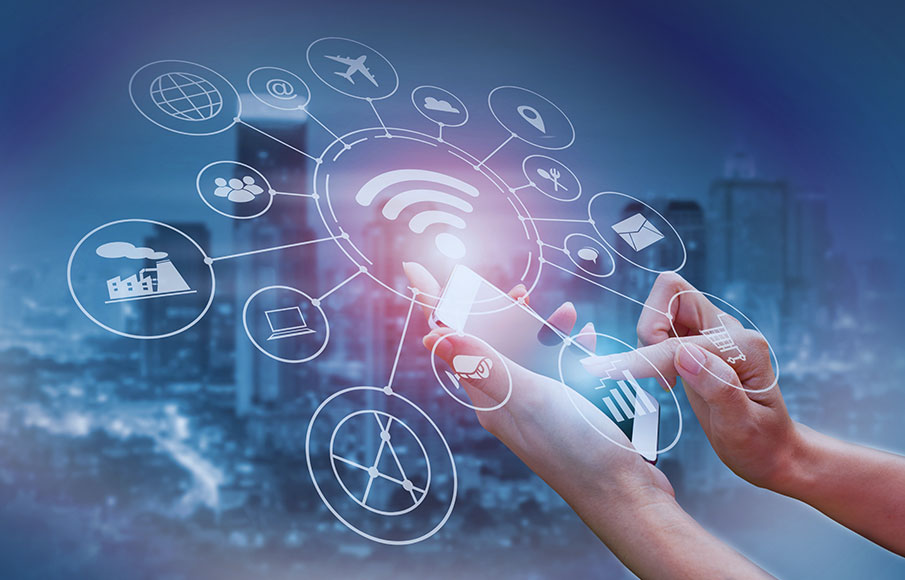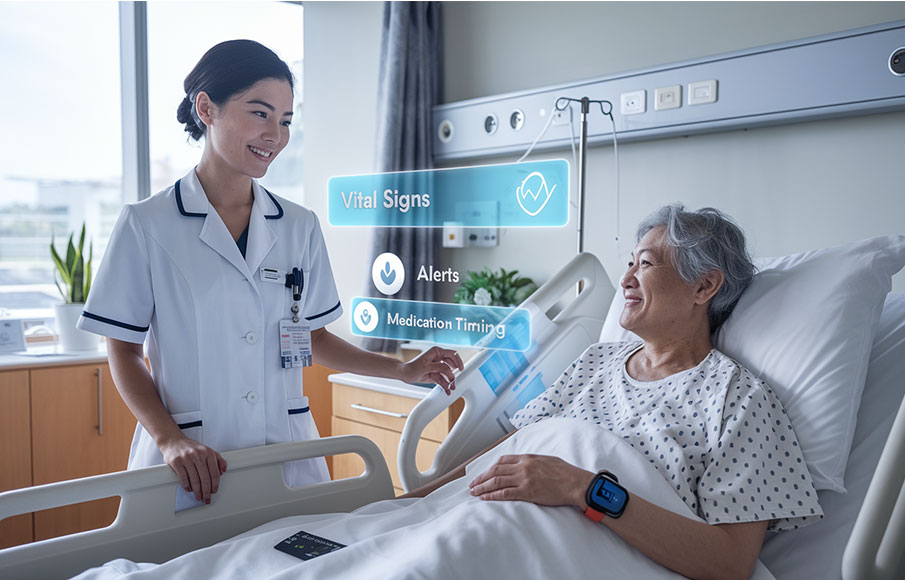Digitalizing Healthcare: Four (4) Key Trends and Technologies
- 28 April 2022
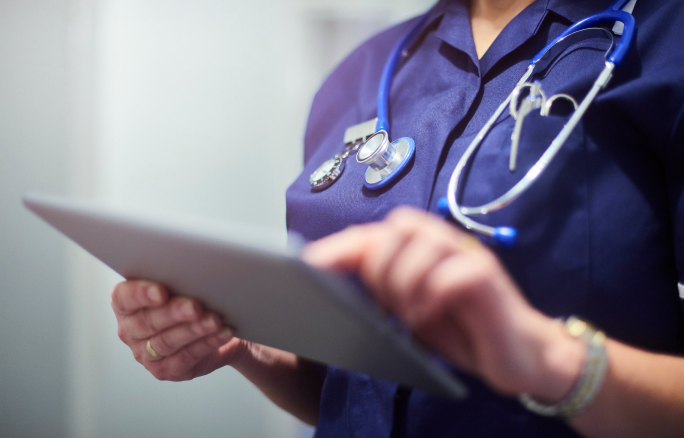
There has been a massive adoption of technology in the healthcare sector since the start of the Coronavirus pandemic. It forced healthcare organisations around the world to look into faster and more seamless ways of ensuring the sick can get the care they need. Today, digitalizing the healthcare sector has brought great improvements, efficiency, and ease to medical processes.
Already we are starting to see some benefits from the rapid digitalization that the healthcare industry underwent to cut down on wastage, automate processes and increase time spent on patient care.
Below are some of the key trends and technologies that have improved the efficiency and standards of healthcare provision.
1. Big data and data sharing

Big data is being utilised in the healthcare industry to aggregate huge collections of patient and hospital information. Big data gives doctors up-to-date information required about patients to help them properly diagnose and detect signs of mild or life-threatening illnesses as early as possible.
Some notable benefits of big data are:
- Detecting diseases at an early stage
- Providing more accurate treatment
- Early alerts
- Greater personalisation of patient care
- Improved accuracy for identifying high-risk patients and forecasting the risks of certain treatment options
- Streamlined hospital operations
With the insights generated from big data, the next question would be accessing and utilising the data for improved decision-making. Data sharing in the healthcare industry refers to the process of sharing useful information about the patient’s current and past medical positions between/among healthcare providers. This streamlines the entire journey of setting an appointment, arranging for diagnosis, and having to repeat care information and medical history.
However, with the benefits that come with data sharing comes the increased risk of security breaches, especially when it comes to classified patient data and PDPA. It is, therefore, necessary that healthcare providers be proactive and look out for possible security countermeasures to prevent the loss of such data due to cyber-attacks or data breaches.
One smart solution for situations like this would be to lay down countermeasures to proactively react to threats with on-demand cyber security. What this does is lower the risk of data loss and security breaches by reacting in real-time to threats to minimise the impact of the security incident.
Another solution is outsourcing cyber security management to an expert Managed Services Provider (MSP) to take the burden of cybersecurity management off your shoulders and help you focus more on your core which is delivering patient care services.
2. Internet of Things (IoT)

With the Internet of Things, healthcare providers can have access to real-time updates on data that can aid in improving patient care. These solutions can range from environmental monitoring, and asset tracking to even patient health monitoring sensors.
For example, a healthcare provider may want to ensure that their medicines and vaccines are kept in a temperature- and humidity-controlled environments. Instead of sending personnel to check on the environment every few minutes, it would be more effective to install smart sensors to alert them of any abnormalities in storage conditions. This also enables improved accountability and tracking for the medical crew with an automatically updated audit trail.
Asset tracking is another area where IoT can play a major role. Hospitals, for example, may want to ensure that they have enough wheelchairs in critical areas such as at arrival bays and near ICUs. With smart sensors on wheelchairs, the operations team can quickly identify where their assets are and move them to where they are needed without having to hunt for them throughout the entire facility.
Wearable medical devices are patient-worn smart devices that aid the collection, analysis, and transmission of data in real-time. These devices help both the medical practitioners and patients to monitor and diagnose their health situations. Some notable examples include ECG monitors, electronic skin patches, glucose trackers, biosensors, blood pressure monitors, asthma monitoring, and many more.
Wearable technology can be integrated with remote patient monitoring (RPM) and workflows so healthcare providers can get real-time updates and alerts about a patient’s current health condition.
In essence, there is an entire IoT network that can be created for healthcare providers encompassing environmental, asset, and patient monitoring. This would greatly increase the accuracy of tracking, reduce time wasted on manual processes and improve standards of care.
However, each of these sensors may be working in a silo, supported by their own device management platform, resulting in complex data management which may require integration and platform development. This could result in the healthcare provider having to own, manage and maintain their own device management platform, increasing the strain on IT teams.
With the help of a multi-protocol IoT platform, hospitals can enjoy the integration of multiple vendor-specific devices into one smart solution. This offers a seamless collection of data across different IoT solutions to piece together a more holistic view of internal operations, assets, and patient health.
SPTel’s IoTaaS (Internet of Things as a Service) is one such solution that can help healthcare providers bridge the gap of having multiple wearables and IoT solutions within their compound. This multi-protocol end-to-end solution combines IoT gateways, device management platforms, compute resources, and backhaul connectivity to provide a one-stop platform for device management.
The service gives businesses the advantage of streamlining the data management and connectivity of the different IoT services that they have without having to invest heavily in R&D and platform set-up costs.
3. Telemedicine

Telemedicine is one of the buzzwords within the healthcare industry, especially post-pandemic where the world was made to minimise interaction and contact to lower the risk of virus transmission. But what exactly is telemedicine? Telemedicine serves as an online meeting point between doctors and patients, helping to streamline the data collection time, foster better communication, and help caregivers to make better-informed decisions.
An example would be a video consultation between a doctor and his patient. This virtual meeting will reduce the need for the patient to meet with the healthcare provider physically, thereby cutting down the waiting time for the patient and reducing the chance of cross-infection.
Telemedicine usually forms one aspect of a Patient Engagement Platform (PEP).
What many of these patient engagement platforms do is allow patients to fill in details about themselves and their health concerns. They also get to answer some pre-set questions posed by the healthcare provider. Patients can also receive automated reminders for billing, appointment, and follow-up care.
PEPs also offer the option to set available dates and times, thereby ensuring that patients can meet them at the most comfortable times for physical meetings or video conferencing without having to wait too long.
Some notable examples of PEPs out there today include the following:
- AdvancedEHR
- athenaOne
- Caspio
- CareCloud
- Allscripts CareDirector
To get the best from telemedicine and patient engagement platforms, a resilient and ultra-low latency network is critical. This reduces situations where calls are abruptly dropped or are impacted by lag time, thereby leading to a smooth and more efficient user experience for both the patient and the care providers.
Another aspect to consider would be catering enough bandwidth to cater for days where there is an unexpected surge in such requests for video conferencing. While user experience cannot be compromised, oversizing the network unnecessarily, especially when taking into account multiple branches or clinics is not cost-effective for the organisation.
Therefore Healthcare providers should consider working with a network partner that can provide scalable bandwidth on demand, to increase their bandwidth on a pay-per-use basis to cater to surges and go back to their existing bandwidth during lull periods to improve their total cost of ownership.
4. Health 3.0

You have probably heard about the concepts of web 3.0 and the semantic web. Health 3.0 is a health-related extension of both concepts. The idea is to make web data accessible for sorting to help streamline how information is presented to a specific user based on their preference. With health 3.0, electronic health records are semantically organised to deliver an Open Healthcare Information Architecture (OHIA). While there are many pillars under Health 3.0, one important area of development is virtual reality.
Virtual reality in medicine also referred to as therapeutic virtual reality, is the use of highly immersive, computer-generated technology in healthcare. There are two ways in which this tech trend is being used currently–for training and treatment.
- In treatment: although there is no realistic way to administer drugs and injections through a computer, there are other ways virtual reality can be used to ease pain and reduce anxiety. A realistic example is to create peaceful environments or scenery for patients with anxiety disorder. With therapeutic VR, they can simply slip on a VR headset and find themselves in their safe zone to quickly ease their anxiety.
- In training: VR can be used to augment the training of doctors and nurses to give them a close to real-life experience for procedures, increasing their ability to handle their first operation or treatment.
With data being the lifeblood of virtual reality transmitting, receiving, and processing this data at speed all combine to create a believable computer-simulated environment.
However, healthcare providers may face the challenge of how to ensure responsive computing while balancing the need to own and manage equipment. Maintaining and managing owned servers on-premise will create the best user experience but it is costly and requires heavy infrastructure investment.
Computing in the cloud or a central data centre is more cost-effective and hassle-free to manage but can give rise to latency issues which may hinder the experience. This is where edge cloud computing comes in.
With edge cloud computing, servers and storage are brought closer to the source of the data, thus boosting processing speed and reducing network congestion.
Also, as VR becomes more widely adopted and used, hospitals might need to prepare for increased reliance on VR equipment in the future. To prepare for this, the supporting infrastructure must have the capability to grow as needs increase. This can mean scaling your compute resources and bandwidth as the situation involves,
Instead of oversizing your network requirements upfront, or being left scrambling to increase your existing infrastructure, solutions like edge computing and bandwidth on demand can help.
With SPTel’s Software Defined Network, we have digitised our processes to offer innovative solutions such as Bandwidth on Demand and even edge compute resources on-demand, to meet your needs. Businesses even have the option of self-service, so they can better control and manage their network requirements via a customer portal.
Conclusion

All four of these key tech trends have improved the processes and efficiency of healthcare provision. They enable patients to receive a higher level of medical care by aiding healthcare providers in offering better and more accurate care services.
One connecting factor to all these tech trends is the need for a super-efficient, scalable and secure network infrastructure. This is because the digitalisation of the healthcare industry has become far more pervasive and complex in the past few years than it was a decade ago. With more processes going digital or online, a simple network outage, delay, or cyber-attack can cause more damage than previously seen.
Why Choose SPTel
What SPTel delivers is a truly diverse and reliable network service to better serve the needs of the healthcare industry with fibre cables that are physically diverse from the incumbents and able to deliver <1ms latency across our entire core network.
SPTel’s network is also end-to-end software-defined, which means that it can scale as needed with services like on-demand bandwidth to handle spikes in network requirements. These on-demand services extend to cyber security services as well as clean pipe protection and on-demand cybersecurity for a proactive approach to detecting and combating cyber threats and intrusions.
With SPTel’s access to pervasive edge hubs around the island for edge computing, data processing can be close to data sources for improved application performance. Coupled with an IoT-a-a-S platform, IoT device management can be further streamlined for more holistic insights and better decision making.



